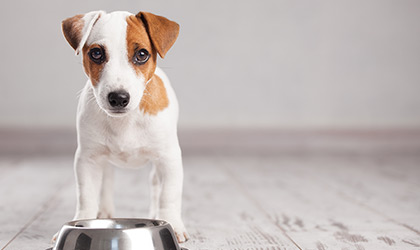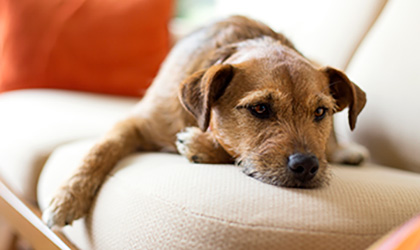
If you’re considering getting a giant breed, the first thing we should say is don’t be intimidated by ‘giant’. Despite weighing over 45kg at full size, these extra large guys can actually make perfect family pets due to their low-energy needs and oh-so-mellow temperament. But it’s not just a question of whether you have space. Thanks to their truly awesome size, these huge hounds have certain caring requirements too, and as an owner, you’ll need to step up to the mark.
Lifespan
As the parent of an XL dog, you’ll have to set yourself for early heartache because, sadly, your big ol’boy will pass on much sooner than his smaller friends. Indeed, there’s a raft of scientific evidence proposing that giant breeds start the ageing process earlier, and thereby develop age-related health issues sooner in life. Don’t be disheartened by this though – you’ll just have to make his doggie years count!
Diet
By virtue of their sheer size and weight, many giant dogs can develop joint and bone problems in later life. Environmental factors, a genetic predisposition or improper diet can bring these health issues to the surface. The good news is that feeding your big ‘un a well balanced, nutritionally dense diet can help support them as they age. To address the special needs of your happy-go-lucky pal, look out for these features in canned food, kibble and treats.
-
High-quality animal-based protein sources for muscle growth, repair and tone
-
Carbohydrate blend to sustain energy by supporting healthy blood sugar levels
-
Less fat to help maintain an optimal body type and minimise joint stress
-
Glucosamine to help support mobility
-
Omega 3 & 6 for a shiny coat, healthy skin and overall health
-
Essential minerals and vitamins to support a healthy immune system
-
Large kibble chunks to avoid the inhaling of food
Of course, keeping your dog trim will help minimise joint stress too. For this reason, it’s vitally important to calculate the correct number of calories he should be eating (your vet can help you here); establish a set feeding routine to monitor eating patterns; get your pooch moving more; and avoid feeding him unhealthy titbits and table scraps. Sure, this rule applies to every dog, but it’s even more pressing if you own a giant breed.
In addition to a well-balanced dog food, supplementation can help plug any nutritional gaps your big friendly giant may encounter. A high-strength multivitamin will pack a mighty punch of antioxidants, vitamins and trace minerals to support the immune system and healthy bones, while an omega 3 and glucosamine supplement will support mobility.
A quick word on ‘bloat’, or as it’s more commonly referred to as a ‘twisted stomach’. Bloat is a very common and serious ailment that affects giant breed dogs. The condition causes the stomach to distend by excessive gas content. Symptoms include a bloated, hard abdomen, difficulty breathing, anxiety, restlessness, excessive salivation and drooling, lethargy and heavy panting. If you suspect your pooch is suffering from this issue, get to your vet pronto. Time is of the essence.
Fortunately, there are some preventative measures to reduce the chances of bloat striking:
-
Feed 2-3 equally portioned meals a day
-
Always add water to kibble
-
Restrict access to water for at least an hour after meals
-
Allow food to settle for an hour after eating before exercising
-
Discourage food-scoffing
-
Feed from a raised food bowl
Exercise
In many cases, moderate, low-impact daily exercise with a sprinkling of mental stimulation will keep your big ‘un happy. 30 minutes to 1 hour of walking, socialising with other dogs, or simply playing fetch is enough will meet his needs. A word of warning: before the age of 2 years old, you should avoid exercising your giant friend on hard surfaces like concrete, and discourage him from jumping in and out of cars. At this young age, his body is working hard to develop a strong structure and such activities could disrupt this vital growing process. Exercise for dogs can vary depending on their size and breed, why not read our article 'How Much Exercise Does My Pet Need?' to understand more.
Grooming
Brushing
Newfoundland’s are just magnificent, aren’t they? But how on earth do you maintain that handsome sheen and lustrous glow with so much fur? Keeping your big fella groomed is vitally important for his health and is, paws down, worth all the elbow grease and hard work. Regular brushing (we’re talking several times per week) really is the secret to maintaining that marvellous mane.
Bathing
As you can imagine, bathing your gentle giant poses great difficulties because of his huge size. Instead of using the tub, we’d suggest putting your pooch on a lead and washing him outside. Always brush your dog thoroughly before bathing him, and be sure to use a specialised dog shampoo. Some giants (particularly those with double coats) could take all day to dry, so will need some help to speed the process along. You could start with a towel and then move onto a hairdryer, should you require it. Oh, and make sure it’s on the cool setting – you don’t want to burn your furry friend!
Nail clipping
No one likes it, but every pooch requires a nail trimming to avoid damaging his feet and toes. Giant breeds need special clippers to handle their large nails, which should just about touch the floor as they walk. As you can imagine, this task comes with its fair share of drama and angst because you don’t want to ‘quick’ claws. To make sure you’re not barking up the wrong tree, always consult your vet to give a demonstration.
Final thoughts
When it comes to looking after your pooch, there’s no blanket approach. Sure, the fundamentals remain the same – you must pledge to love, care and safeguard the wellbeing of your hound no matter what. But beyond that, the real vehicle dictating your doggie day-care routine is ‘size’ and ‘breed’, especially for XL varieties. With the correct, giant-friendly nutrition, exercise and grooming support, you can equip your big pal with the tools needed to live a fruitful, happy and healthy life.
References:
-
Blue Cross. (2018). Choosing the right dog breed. Available online: https://www.bluecross.org.uk/pet-advice/choosing-right-dog-breed
-
Pets4Homes. (2018). Five care and management considerations specific to giant dog breeds. Available online: https://www.pets4homes.co.uk/pet-advice/five-care-and-management-considerations-specific-to-giant-dog-breeds.html
-
Pets4Homes. (2018). How the right kind of exercise can support large breed dogs joint health. Available online: https://www.pets4homes.co.uk/pet-advice/how-the-right-kind-of-exercise-can-support-large-breed-dogs-joint-health.html



